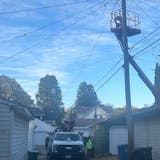In 1937, Minneapolis motorcycle cops escorted 12-year-old Walter Shimshock and his 13-year-old brother Bernie to the Great Northern Depot, along with the other outstanding Tribune carriers about to embark on an all-expenses-paid trip to Chicago.
Seven years later, Nazis executed Walter in Poland — pouring bullets into the 19-year-old U.S. Army Air Force rear gunner from northeast Minneapolis, fresh out of DeLaSalle High School.
Staff Sgt. Shimshock had bailed out of his burning B-17 bomber that was dropping supplies for Polish resistance fighters, who were then locked in a two-month clash with occupying German forces, now known as the Warsaw Uprising. He broke his leg parachuting down to the waiting Nazis, who interrogated and tortured him before killing him.
Bernie clung to memories of that Chicago trip with Walter, and watching the Cubs play the Dodgers, until his own death in 2005. His brother was just a kid when he entered World War II, Bernie told the Star Tribune in 2004.
“Biggest thing we ever did before he went in was a trip to Chicago in 1937 to see our first baseball game and ride on the El,” Bernie said.
Now, despite dying as a teenager 80 years ago this September, Walter Shimshock will further cement the ties between sister cities nearly 4,700 miles apart — Columbia Heights and Lomianki, Poland.
A memorial to Shimshock and his nine airlift crewmates will be unveiled next month at Huset Park in Columbia Heights, a couple miles north of Walter and Bernie’s childhood home in northeast Minneapolis. The Warsaw Uprising Airlift Memorial, a triangular obelisk and plaque, mirrors a similar monument that Polish leaders erected two years ago at the crash site of Shimshock’s bomber outside Lomianki.
Never mind that Shimshock’s B-17 was the only one of 107 Allied bombers shot down while dropping hundreds of canisters of food, ammunition and medicine on beleaguered Warsaw on Sept. 18, 1944, during a mission called Operation Frantic 7.

